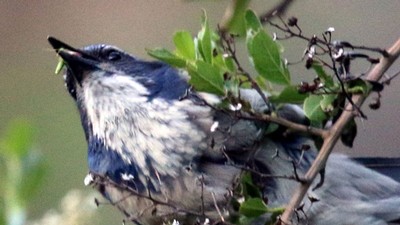Summer Plunge: California Aggie Alums Host Teen Scientists at USU Lab
With USU alum and high school chemistry teacher Russell Butler, center, California teens, from left, Ludy Rivera, Rosa Silva, José Sanchez and Chris Arrington bust a move outside Widtsoe Hall. Butler and fellow alum Megi Rexhepaj arranged the visit.
Utah State University biochemistry alums Megi Rexhepaj ’12 and Russell Butler ’12 cherish memories of their undergraduate experiences and are grateful for the research opportunities afforded them as fledging scientists. So much so, they wanted to create a similar experience for teens from Oakland, California’s, Castlemont High School where Butler is teaching chemistry as a member of AmeriCorps’ Teach for America program.
“My students face challenges many of us never dream of and I felt they deserved more,” says Butler, who approached Rexhepaj, a research associate at Novato, California’s, BioMarin Pharmaceutical, with the idea of bringing students to Logan for a summer research experience.
Together, the Aggie biochemists hatched a plan and from June 22 to July 10, 2015, Castlemont High students Chris Arrington, Ludy Rivera, José Sanchez and Rosa Silva learned to wield pipettes, process gels and purify proteins as they developed a mini-research project in the lab of USU Department of Chemistry and Biochemistry faculty member Joanie Hevel.
Chemistry and Biochemistry Department Head Alvan Hengge, who attended the teens’ research presentation at the conclusion of their USU visit, was astounded by their progress.
“They did an outstanding job and demonstrated great teamwork,” he says. “It was obvious they took this experience very seriously and put a lot of thought and hard work into their research. Their efforts, in such a short amount of time, are really quite remarkable.”
Even more remarkable, perhaps, are the efforts and teamwork that brought the teens to Logan.
Butler and Rexhepaj reached deep into their own pockets to cover much of the students’ travel costs, as well as recreational activities, during the youths’ two-week Utah stay. They praise Whitney Milligan and Katie Bohm of USU Housing and Residence Life, who arranged dorm lodging and $50 meal cards for each student. The Department of Chemistry and Biochemistry also provided funding.
“We selected these students based on a required written essay about what they hoped to gain from the experience, their GPAs and classes completed,” Butler says. “But we had many deserving students and it was heartbreaking to turn them down.”
The four high schoolers, who made the most of the opportunity, are quick to express appreciation.
“I hope more people can come next year,” says Rivera, who hopes to study psychology or psychiatry after graduating from high school next spring. “Some of the people who wanted to come this year never got a chance.”
What did the Bay Area teens, most of whom had never ventured out of their home state, look forward to on their Utah visit? Seeing the Great Salt Lake? Going camping for the first time? Swimming in a mountain lake? Living on a university campus?
All of the above, but their initial, sobering answer was, “Being in a safe place, without violence.”
“Logan is very different from Oakland,” says Arrington, who starts his senior year of high school this fall, and is mulling a combined computer science and biochemistry college major. “No gun shots. No car crashes.”
“I feel safe here,” says Silva, who wants to attend college and pursue medical research. “The people are so friendly.”
Butler says his students aren’t exaggerating. On his first day at Castlemont, bullets were fired through a classroom window.
“We take a lot of things for granted here at Utah State,” he says. “Many of my high school students struggle to get by each day, let alone consider the possibility of a college education. These are roses growing up in concrete.”
A former foster child, Butler, who was named USU Chemistry and Biochemistry’s top graduating senior in 2012 and an undergraduate recipient of an American Heart Association Research Fellowship, notes his own troubled childhood.
“Utah State empowered me,” he says. “A lot of other schools wouldn’t have given me a chance with my high school record. I want my students to be aware of opportunities as well.”
Rexhepaj, who faced challenges as an Albanian immigrant and was also an AHA Research Fellow at USU, says she felt a “sense of family” at Utah State.
“(USU Biochemistry faculty members) Joanie Hevel and Sean Johnson were incredible mentors and we want to pass it on,” she says. “In fact, Joanie and Sean are researching grant opportunities to help us bring more teens to Utah State next year.”
Sanchez, who says he wasn’t considering college before visiting Utah State, says he hopes more of his classmates will participate in the program next year.
“I highly recommend this program to people who are struggling,” says the teen, who now plans to study culinary arts or biochemistry. “This might change their mind. There are better environments. You might find something you never found before.”
Related links:
USU Department of Chemistry and Biochemistry
Contact: Joanie Hevel, 435-797-1622, joanie.hevel@usu.edu
Writer: Mary-Ann Muffoletto, 435-797-3517, maryann.muffoletto@usu.edu
From left, Rosa Silva, Megi Rexhepaj, Ludy Rivera, Chris Arrington, José Sanchez and, in back, teacher Russell Butler, in the lab of USU Chemistry and Biochemistry faculty member Joanie Hevel. The California teens spent two weeks at Utah State.
TOPICS
Chemistry 110storiesComments and questions regarding this article may be directed to the contact person listed on this page.








